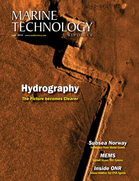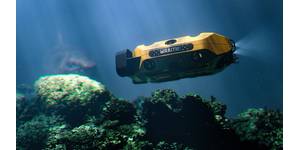VectorNav Launches VN-300
Posted by Irina Tabakina
VectorNav Technologies introduced the VN-300 Dual Antenna GPS-Aided Inertial Navigation System (GPS/INS). The follow-on product to the VN-100 IMU/AHRS and VN-200 GPS/INS, the miniature VN-300 enables a wider range of applications through the incorporation of GPS compassing techniques.
The VN-300 can be used in a variety of industrial and military applications and is well suited for size, weight, power and cost (SWAP-C) constrained applications such as unmanned vehicle systems; antenna, camera and platform stabilization; heavy machinery monitoring; robotics; and primary or secondary flight navigation among others.
Incorporating the latest MEMS sensor technology, the VN-300 combines 3-axis accelerometers, 3-axis gyros, 3-axis magnetometers, a barometric pressure sensor, two GPS receivers, as well as a low-power micro-processor into a rugged aluminum enclosure about the size of a matchbox. When in motion, the VN-300 couples the position and velocity measurements from the onboard GPS receivers with measurements from the onboard inertial sensors to provide position, velocity and attitude estimates of higher accuracies and with better dynamic performance than a standalone GPS receiver or Attitude Heading Reference System (AHRS). The dual GPS receivers incorporated into the VN-300 also provide the added benefit of accurate True North heading measurements when the sensor is stationary through the use of GPS compassing techniques. The VN-300 is suited for applications that require a highly accurate inertial navigation solution under both static and dynamic operating conditions, especially in environments with unreliable magnetic heading and good GPS visibility.
VN-300 Features:
The VN-300 has favorable size, weight, and power requirement characteristics
With Development Kits priced around $5,000, the VN-300 is competitively priced
The GPS compass feature coupled with the GPS/INS capabilities on the VN-300 enables applications that require high accuracy position, velocity, and attitude measurements under both static and dynamic operating conditions.
The algorithms on board the VN-300 enable applications to seamlessly transition between static and dynamic operations without having to collect extended stationary measurements or perform specific dynamic maneuvers in flight for attitude alignment.
The VN-300 incorporates a “True INS Filter” that does not force any requirements on alignment of the sensor to the velocity direction of a platform or specify the orientation of the sensor for initial alignment.
“The VN-300 is unique in that it provides a complete, high performance GPS-aided navigation solution under both stationary and moving conditions, all in a miniature and cost-effective package,” said John Brashear, President, VectorNav. “By addressing some of the most difficult issues users face when trying to integrate an inertial navigation system, the VN-300 will enable an unprecedented number of applications.”
e: [email protected]
(As published in the June 2014 edition of Marine Technology Reporter - http://www.marinetechnologynews.com/Magazine)


 August 2025
August 2025



